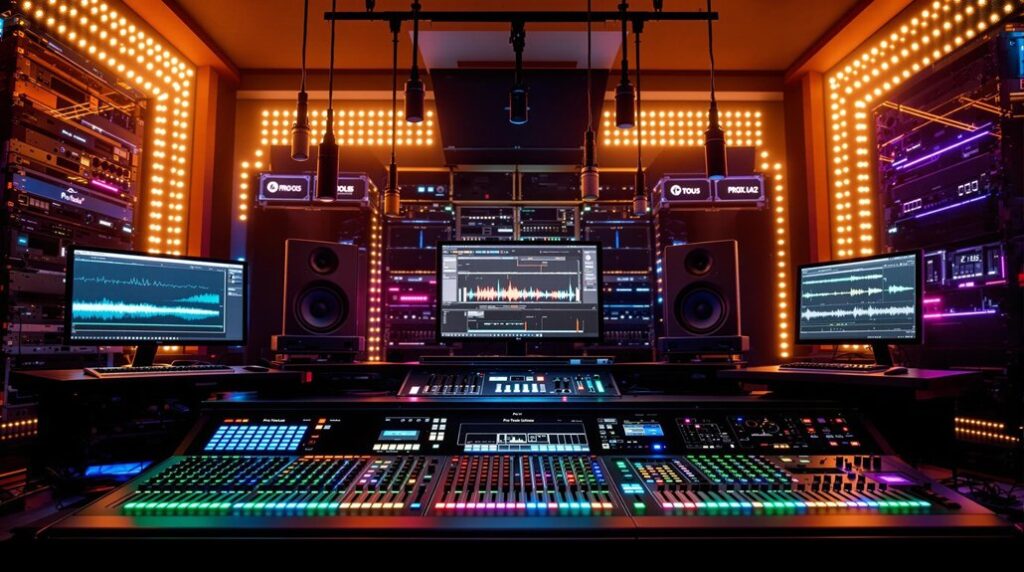Pro Tools and Logic Pro cater to diverse audio production needs with key differences. Pro Tools utilizes a subscription-based model and boasts cross-platform compatibility, accommodating both macOS and Windows users. Logic Pro, however, offers a one-time purchase exclusively on macOS, emphasizing user-friendly interfaces. Regarding recording and editing, Pro Tools' advanced automation and track capabilities excel, whereas Logic Pro provides streamlined MIDI editing with smart tempo features. Plugin ecosystems also differ, with Pro Tools supporting AAX and Logic Pro relying heavily on AU stock options. These distinctions greatly shape user choices and project outcomes. There's much more beneath the surface.
Key Takeaways
- Pro Tools offers subscription pricing with multiple tiers, while Logic Pro is a one-time purchase of $199.
- Pro Tools is compatible with both macOS and Windows, whereas Logic Pro is exclusive to macOS.
- Pro Tools has a steep learning curve, while Logic Pro provides an intuitive user interface.
- Pro Tools supports up to 256 mono audio tracks, ideal for complex projects; Logic Pro excels in MIDI editing.
- Logic Pro includes comprehensive built-in instruments, whereas Pro Tools requires subscriptions for additional plugins.
Payment Models and Costs
When evaluating digital audio workstations, understanding the payment models and costs is essential for making an informed decision.
Pro Tools operates under a subscription-based pricing model, offering tiers like Pro Tools Artist at $99/year, Pro Tools Studio at $299/year, and Pro Tools Flex at $999/year. This approach can lead to a higher overall cost of ownership due to potential hardware requirements and upgrade fees. However, a free trial is available for users to assess its features.
In contrast, Logic Pro offers a one-time purchase option at $199, making it an attractive cost structure for indie musicians seeking affordability. Logic Pro includes all updates at no additional cost, providing long-term financial predictability compared to Pro Tools' recurring expenses.
Platform Compatibility
Platform compatibility plays a vital role in the selection of a digital audio workstation (DAW), influencing both the workflow and the hardware integration capabilities for audio professionals.
Pro Tools offers robust platform compatibility through supporting both macOS and Windows operating systems, thereby providing flexibility to Pro Tools users across diverse systems. This adaptability guarantees seamless integration with various hardware setups, particularly including Avid HDX systems, which enhances performance in professional environments. Furthermore, the use of Hybrid Engine technology in Pro Tools HDX allows seamless switching between Native and DSP processing, optimizing performance and minimizing latency.
Conversely, Logic Pro X's exclusive availability on macOS limits its accessibility for users reliant on Windows operating systems. However, this exclusivity allows Logic Pro to optimize performance and stability by utilizing the macOS ecosystem.
Understanding these platform considerations is essential for users evaluating the shift between these digital audio workstations.
User Experience
Pro Tools offers a robust user experience centered around its industry-standard status, which can be intimidating due to its steep learning curve. Its user interface, segmented into Edit and Mix windows, is tailored for detailed audio editing and professional session management. This complexity benefits experienced users but challenges newcomers. In contrast, Logic Pro offers a more intuitive user interface with a single Arrange window, streamlining music production and navigation. Its design caters to varying skill levels, simplifying the learning process. Continuous updates from Apple guarantee Logic Pro's user experience remains seamless and evolving, making it more accessible for musicians and composers. Users can take advantage of Pro Tools tutorials and documentation for guidance, which are part of the learning resources available to help navigate its complexities.
Recording and Editing Features
In the sphere of digital audio workstations, the recording and editing capabilities of Pro Tools and Logic Pro X exhibit notable distinctions, catering to different professional needs.
Pro Tools supports up to 256 mono audio tracks, providing robust recording features for complex sound design and larger ensembles. Its loop record feature and Elastic Audio enhance audio editing, facilitating seamless comping and precise pitch/time adjustments. Pro Tools also offers advanced automation tools and a dedicated MIDI editing interface. For optimal audio quality, proper microphone placement and soundproofing techniques should be implemented during recording sessions.
In contrast, Logic Pro X offers smart tempo, allowing recordings without a metronome, and customizable key commands for efficient audio editing. While Logic Pro's MIDI editing is more streamlined, it lacks Pro Tools' extensive automation and track arming options, targeting streamlined workflows.
Stock Effects and Plugins
Among the myriad features that define digital audio workstations, stock effects and plugins are pivotal in shaping the creative possibilities for audio producers.
Pro Tools and Logic Pro each offer distinct advantages in this area:
- Pro Tools Stock Effects: Pro Tools includes essential audio effects and offers an annual subscription for additional plugins, emphasizing professional-grade audio production.
- Logic Pro Built-in Instruments: Logic Pro provides an extensive suite of built-in instruments, such as Alchemy and vintage keyboards, ideal for music composition and sound design.
- Plugin Format Compatibility: Pro Tools supports AAX plugins, enabling integration with numerous third-party options, while Logic Pro uses the AU format for widespread compatibility.
- All-in-One Solution: Logic Pro's thorough stock plugins meet diverse production needs, minimizing reliance on third-party plugins.
Both DAWs excel in offering robust stock effects and plugins tailored to different audio production requirements. Pro Tools utilizes stock AAX plugins to build a strong foundation for audio enhancement and sound manipulation.
Frequently Asked Questions
What's the Difference Between Logic Pro and Pro Tools?
Logic Pro and Pro Tools differ considerably in audio editing, MIDI capabilities, and plugin support. Logic offers a streamlined user interface, cost-effective pricing, and robust MIDI features, whereas Pro Tools excels in professional-grade editing, collaboration, and performance optimization.
What Does Pro Tools Have That Logic Doesn't?
Pro Tools excels in audio editing, offering robust automation features and advanced track management. Its superior plugin support, session compatibility, and video integration, alongside efficient collaboration tools and a professional mixing console, distinguish it from Logic Pro.
What Are the Disadvantages of Logic Pro?
Logic Pro limitations include restricted compatibility to macOS, lack of AAX plugin support, and a challenging learning curve for advanced features. Performance issues may arise with high track counts, impacting user interface responsiveness and necessitating frequent updates for peak functionality.
What Are Some of the Differences Between Standard Pro Tools Software and Pro Tools Ultimate Software?
Pro Tools Ultimate offers enhanced features such as increased track count, advanced post-production capabilities, and extensive surround mixing. It supports HDX systems for superior performance. These upgrades justify the higher Pro Tools pricing, enhancing Pro Tools workflow and collaboration.
Conclusion
In comparing Pro Tools and Logic Pro, significant distinctions arise in payment structures, with Pro Tools offering subscription-based models and Logic Pro providing a one-time purchase. Platform compatibility varies, with Pro Tools being cross-platform and Logic Pro exclusive to macOS. User experience differs, catering to varying levels of expertise. Recording and editing capabilities are robust in both, yet nuanced in implementation. Stock effects and plugins further differentiate these DAWs, each offering unique tools tailored to specific production needs.




